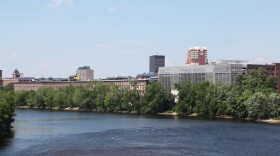Too often, says civil engineer Fred McNeill, it takes a disaster – sinkholes swallowing cars or dam bursts flooding communities -- to get the attention of officials and others who fund the underpinnings of wastewater treatment and dam infrastructure.
McNeill, Chief Engineer at the Environmental Protection Division in Manchester, John Boisvert, Chief Engineer at Pennichuck Water, and Jim Gallagher, Chief Engineer at the N.H. Department of Environmental Services, joined The Exchange to discuss the condition of the state’s wastewater treatment and dams – part of an Exchange in-depth series on the state’s infrastructure.
Foregoing maintenance and upgrades can be expensive. In 2015, Boisvert said, a sinkhole opened on I-93 as a result of a collapsed storm drain. "How much money was spent with just people sitting in traffic waiting to get where they needed to get to," he said. "Or other businesses that may have been impacted because of that?"
Aging Systems
There are more than 1,000 miles of sewer infrastructure in the city of Manchester, amounting to more than $1 billion of wastewater assets. Some of this infrastructure was expanded through the Clean Water Act in the 1970s, and was 90-percent funded by the federal government.
"Then nobody wanted to charge any money to maintain it, because the federal government had just built it and it was all brand new," McNeill said. "So we actually have decades of under investment."
Jim Gallagher, of the N.H. Dept. of Environmental Services, said dams are also suffering from age. "The average age of the dams in New Hampshire is 90 years old," he said.
There are more than 2,600 dams in the state, and 146 of them are considered "high hazard," meaning failure would cause property damage and loss of life. There are 150 "significant hazard" dams, whose failure would damage major highways and roads, and more than 500 "low hazard" dams, near small and local roads.
Climate Change
Climate change has caused a significant increase in severe weather patterns, including storms that cause damage and flooding, according to the engineers, and the current funding for water infrastructure is based on an outdated model created in the 1970s. Severe weather and warmer temperatures have caused more damage than the state budget for repairs can handle, they say.
For example, dams use models to predict how much water to drain into reservoirs to protect shorelines and maintain storage. "We refill [the dams] back based on guided curves that were developed based on past climate patterns," Gallagher said. "But now, if we're not going to be getting the snow we were going to get, if we're going to get those February rains, those guide curves are obsolete."
McNeill said managing wastewater and planning projects also involves taking climate change into consideration. "In the water industry, your number one expense is energy because you have to pump and move water," he said. "Anything we can do to reduce energy is a savings to our city and our customers. So we've been working with DES [Department of Environmental Services] nationally and locally for several months on an energy audit on our plant."
Funding
Both Governor Sununu and President Trump laid out plans to funnel more money into infrastructure, particularly roads and bridges, but the engineers worry not enough money will be directed toward water infrastructure.
"I'm looking at it as a glass not half-full but as primarily half-empty," Boisvert said. "It's going to take a while to get that money down to the smaller utilities."
McNeill expects a "trickle-down effect" that won't provide significant funding increases for smaller communities.
Currently, 100 percent of maintenance and repair of water -treatment systems falls on the rate payers, according to Boisvert. "The major sources of outside funding have fallen...The majority of the focus is still on roads, bridges, highways, paving, and those things that are very visible to the public," he said.
Gallagher said that the best way to improve this shortfall is through awareness. "This legislature and this governor and governors past have understood the importance of dam safety and have funded the repair and construction of state-owned dams," he said.
The challenge, McNeill said, is to get lawmakers, officials, and the public to recognize the urgent need for funding systems that are largely invisible yet essential to daily life.
"As we said, this is not a glamorous industry, and when your town is faced with a new school or a new fire department, or [the need] to fix some pipes that are underground that nobody can see, generally the fire station, the police, get that funding and the underground assets do not."
To hear the full conversation, and to see pictures of recent damage due to water infrastructure failure, please visit our show page.








